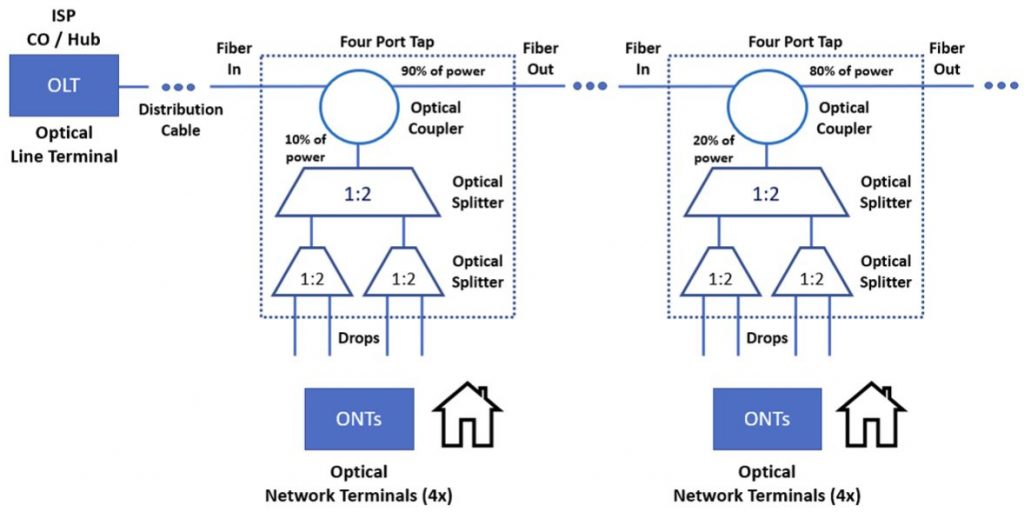
When ISPs deploy fiber broadband service to rural areas, the biggest challenges they face are economic. Like any business, and in the absence of government regulations or mandates, ISPs will offer services first to those dwellings and businesses with the lowest total cost of deployment. (The resulting lower capital and operating costs yield higher returns.)
 This reality is in flux since broadband Internet access is increasingly recognized as a basic utility and an important public good. During the pandemic, skyrocketing needs for remote learning and remote work capability combined with fickle political fortunes to accelerate this shift in perspective. Political and industrial leaders in the US and abroad have even suggested broadband access be considered a fundamental human right.
This reality is in flux since broadband Internet access is increasingly recognized as a basic utility and an important public good. During the pandemic, skyrocketing needs for remote learning and remote work capability combined with fickle political fortunes to accelerate this shift in perspective. Political and industrial leaders in the US and abroad have even suggested broadband access be considered a fundamental human right.
Over the past several years, the US Federal Communications Commission (FCC) has shown impressive resolve to close the so-called digital divide separating urban and rural citizens. The Emergency Broadband Benefit Program (EBBP), the Connect America Fund (CAF) and the Rural Digital Opportunity Fund (RDOF) call to mind the massive push for electrification across the rural US, propelled by Franklin Roosevelt’s New Deal. Subsidized broadband deployment to rural areas may soon benefit from the huge Biden administration infrastructure spending program.
Fiber-to-the-home services in urban areas overwhelmingly utilize a passive point-to-multipoint downstream content distribution model, in which symmetric power splitters ensure all endpoints receive sufficient laser light energy and IP addresses filter that content to ensure accurate delivery of packets to their proper destination. Upstream packets also share a single channel, typically using time division multiple access methods. A key benefit of passive networks is that they avoid the need for optical repeaters and signal amplifiers to extend reach.
FTTH PON architecture has been wildly successful in serving the needs of urban (at least 1,000 people per square mile) and suburban residents (between 1,000 and 500 people per square mile), but not when deployed to rural areas (fewer than 500 people per square mile). Rural areas require longer, costlier f iber cable run lengths, and passive symmetric power splitting is not always optimal for signal distribution, particularly in sparsely populated remote villages.
Suppliers of outside plant optical components have innovated two approaches to adapt FTTH PON technology to rural applications: asymmetric unbalanced (or tapered) splitters and distributed taps.
Tapered Power Splitting
Symmetric splitters generally offer a “power of 2” number of power splits (typically 4, 8, 16, 32 or 64) where each output branch receives an equal (symmetric) share of the input power from the optical line terminal (OLT).

Symmetric splitters generally offer a “power of 2”.
This equal allocation of light from the OLT among optical network terminals (ONTs) is appropriate in densely populated areas, as the distance of each dwelling or business from the centrally located symmetric splitter is roughly the same. However, in rural areas, subscribers are generally not clustered geographically. In these situations, asymmetric power splitting can help maximize reach.
Often tapered power splitters are 1:2, with one output branch being the lower insertion loss “express port” and the other output branch a higher insertion loss “local port” that connects directly to a subscriber ONT, or to a symmetric power splitter to serve a cluster of homes or businesses.

In this example, the local port receives 10% of the transmitted light from the OLT, while the express port receives 90% of the input power, preserving as much power as possible for the downstream tapered splitter to maximize reach out to more remote subscribers.
Tapered splitters are passive optical components and have several characteristics—insertion loss, reflective loss, polarization-dependent loss, and directivity—that network designers must bear in mind when determining overall PON system performance.
Spliced Optical Distributed Taps
One key to the cost savings associated with distributed taps, as claimed by their suppliers, relates to the reduced amount of fiber cabling (distribution and drop cables) required as compared with centralized symmetric power splitter network configurations. Passive distributed taps, as shown below, implement a linear or serial daisy-chain architecture that will be familiar to engineers and technicians with experience in hybrid fiber cable (HFC) topologies. While coaxial cable taps work in the electrical domain, and the distributed taps under discussion here work in the optical domain, the basic signal tapping theory of operation is similar. This functional similarity translates into lower training costs for network operators whose technicians are familiar with electrical coaxial components and technology.
Distributed taps comprise optical couplers, which divert a portion of the input light power, and optical splitters, which equally split this diverted light into the drop outputs.

This example shows two cascaded 1:2 splitters to create four drop outputs. Note that the first tap extracts 10% of the light power, and the second tap extracts 20% of the remaining light power.
Another advantage of distributed taps is reduced splicing overhead, with only one fiber cut and two splices required to add each tap. The small physical size of tap terminals allows them to be mounted aerially, avoiding the need for equipment cabinets, mounting pads, labor costs and the associated local government approvals for this infrastructure.
Distributed taps have two important optical performance parameters that impact end-to-end optical loss budgeting. The first is the tap value or drop loss, and specifies the optical power extracted by the tap, between the input distribution fiber and the output drop fibers (the remaining optical power passes to the next tap in the PON). All the drop ports in each tap along the link (four in the example above) have the same drop loss. Taps closer to the optical line terminal (OLT) extract less optical power from the trunk than taps further from the OLT, in order to allow these PONs to have maximum reach; this is particularly important in dispersed rural areas. The second performance characteristic is tap insertion loss, the amount of light power (both typical and maximum) diverted from the input distribution fiber to the output distribution fiber. The final tap in the PON is the terminating tap, and it has no output fiber port, as all the light energy passes to the drop ports.

Here is a simplified illustration of the downstream path using typical loss values to help make these parameters clearer. Note that the attenuation of all connectors (below 0.75 dB for SC APC per IEC standards), fusion splices (below 0.3 dB per IEC standards), and the fiber itself (about 0.2 dB per km at 1490 nm) must be included in an actual engineering optical loss budget accounting.
A key takeaway here is the available range of tap values (drop losses) from their suppliers allows the network engineer to manage the optical link budget so that ONTs near and far from the OLT receive adequate transmit light signal power. This design methodology also manages the 1310 nm upstream signal power from the ONTs back to the OLT.
With distributed tap PON architecture, along with tapered splitter PON architecture, service providers have two options to deliver fiber broadband services to underserved rural areas cost effectively. EXFO’s broad portfolio of fiber test tools, including PON power meters, optical fiber multimeters, inspection scopes, and OTDRs with iOLM, are perfectly suited to validate and maintain all types of passive optical networks.
